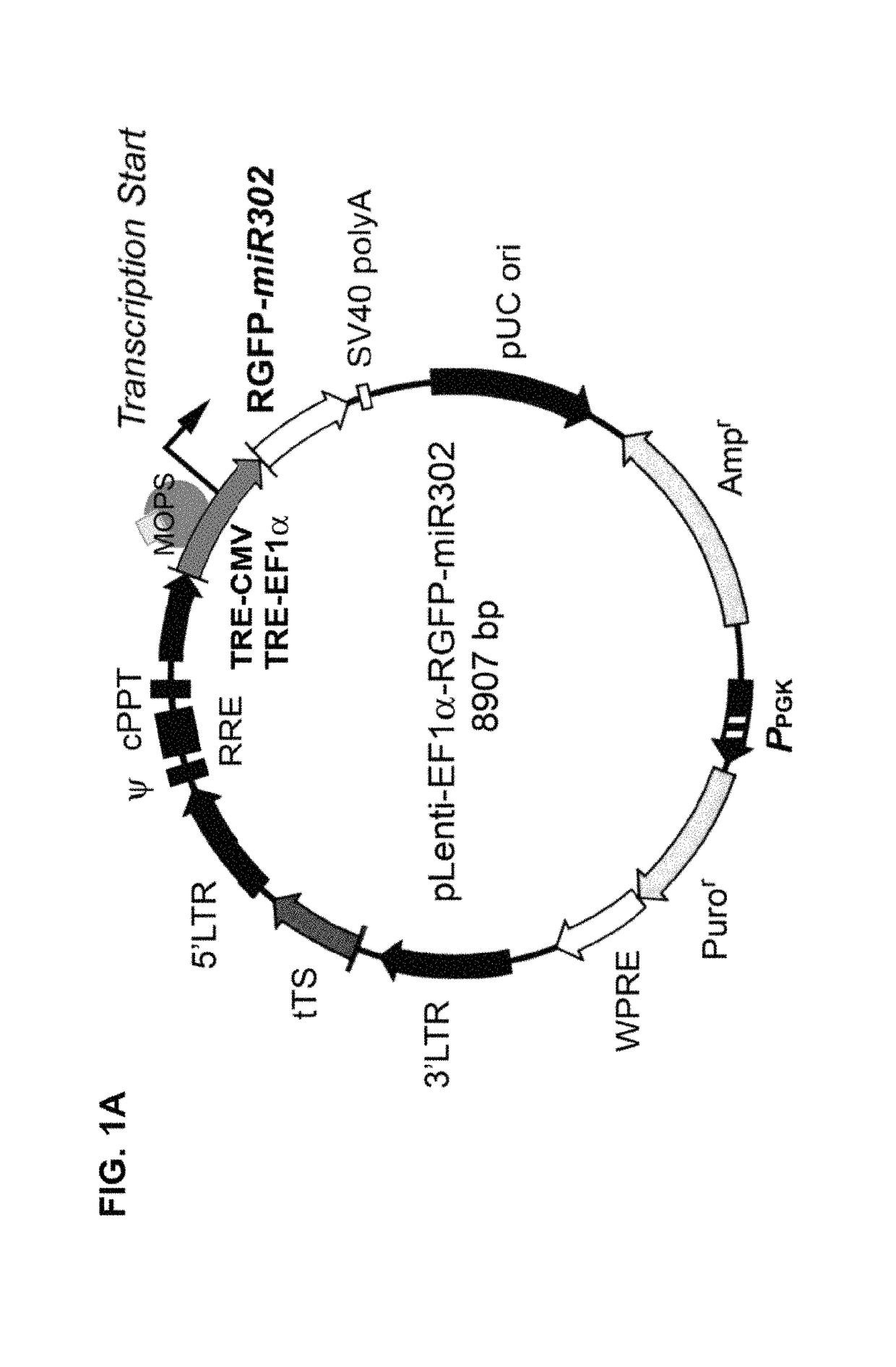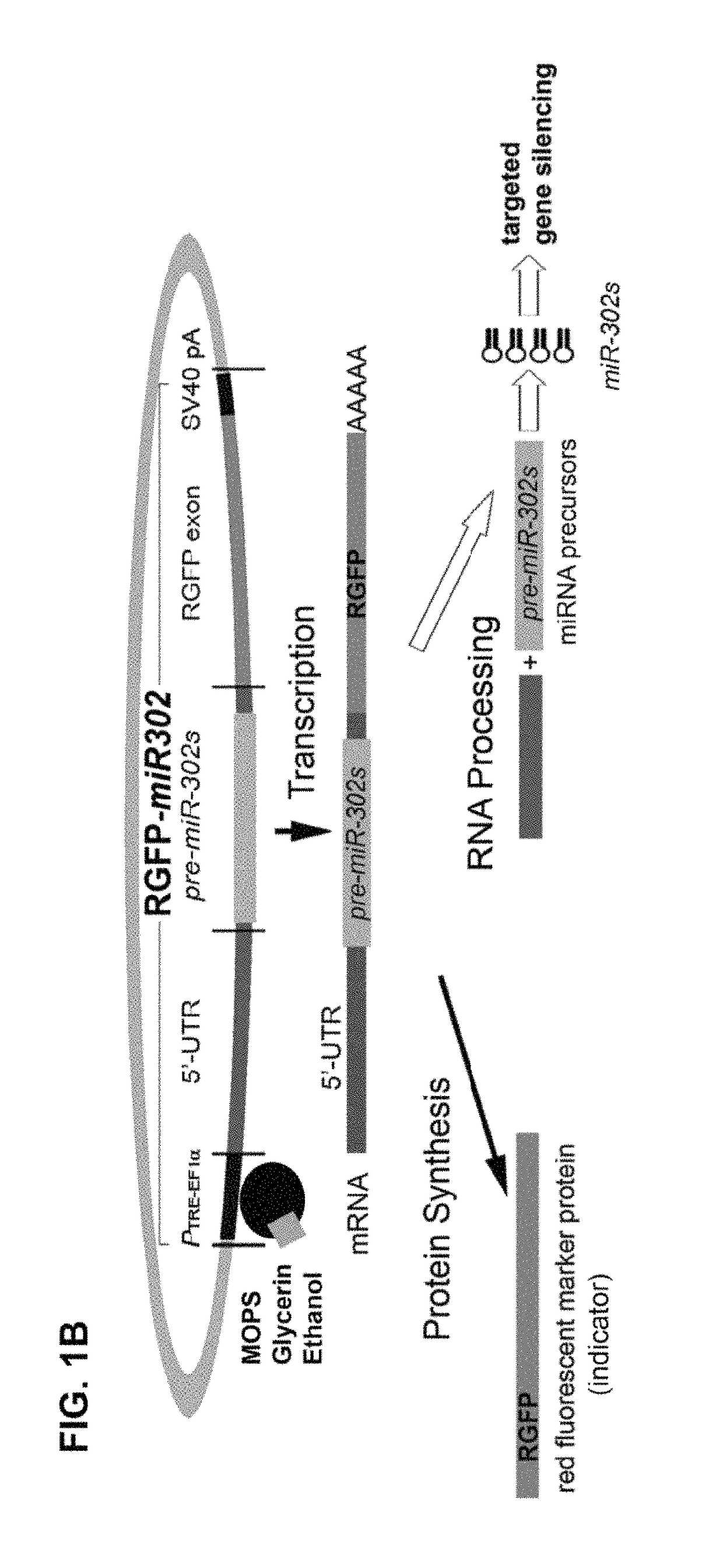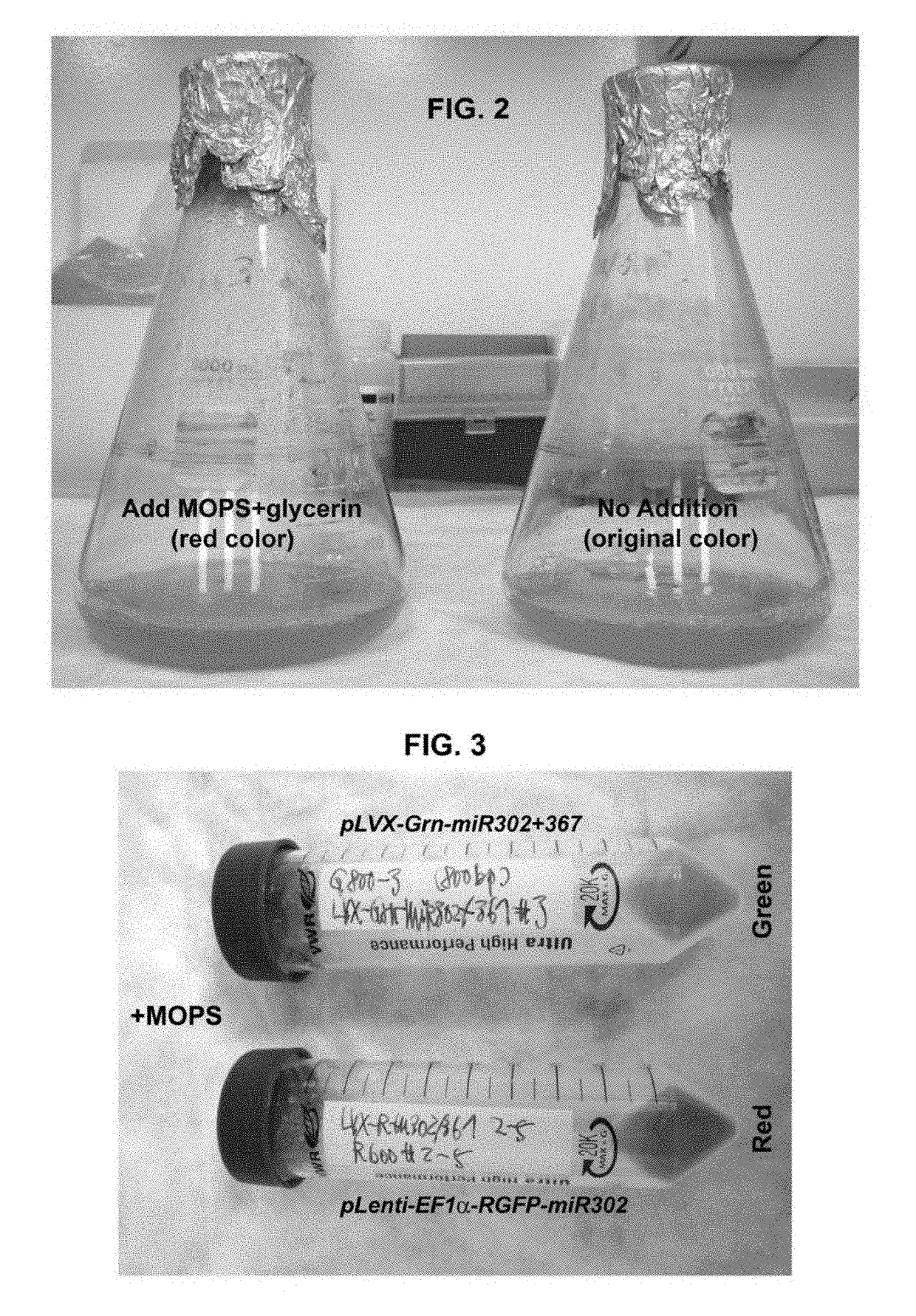[0014]Based on the above knowledge, the present invention is a design and method for utilizing prokaryotic cells to produce human microRNA precursors (pre-miRNAs) and / or shRNAs as therapeutical drugs and / or vaccines for cancer therapy. More specifically, the present invention is a design and method of utilizing prokaryotic cells to produce a special kind of pre-miRNA-like agents, named pro-miRNA, that are capable of reprogramming the malignant properties of high-grade human cancer cells into a low-grade benign or even relatively normal-like state. Preferably, these pro-miRNAs are tumor suppressor microRNAs (TS-miRNA) similar to the precursors of miR-302a, b, c, d, e, and / or f (pre-miR-302s) and their natural familial cluster as well as their manually re-designed small hairpin RNA (shRNA) homologues / derivatives, and / or a combination thereof. The designs of pro-miRNA-like shRNA homologues / derivatives include imperfectly and perfectly matched hairpin conformations of the pro-miRNA and its homologous small interfering RNA (siRNA), which may be formed in a single unit or in a multiple unit cluster. Also, the mismatched part of a pro-miRNA-like shRNA can be located in either stem arm or loop region, containing about 30% to 100% homology to the desired pro-miRNA sequence(s). These designs may improve the target specificity and / or reduce the copy number of pro-miR-302 required for effective delivery and therapy. The human cells suitable for such a drug treatment include normal, tumor, and cancerous cells in vitro, ex vivo and / or in vivo.
[0025]MiR-302 has been reported to reprogram mammalian somatic cells to human embryonic stem cell (hESC)-like induced pluripotent stem cells (iPSCs) as demonstrated in our priority U.S. patent application Ser. No. 12 / 149,725 and Ser. No. 12 / 318,806. Numerous stem cell applications and therapies have been designed and developed using these iPSCs. Nevertheless, since cultivating these iPSCs and hESCs is very costly and laborious, it is difficult and inefficient to collect miR-302 and its precursors from these pluripotent stem cells. On the other hand, making synthetic shRNA mimics is another possible alternative for pre-miR-302 production; yet, the cost is still very expensive. Also, the similarity between synthetic shRNA and natural pre-miR-302 is very questionable. To solve these problems, the present invention provides a simple, cheap and efficient method for mass production of pre-miR-302 in prokaryotes. Moreover, the extraction and purification of these prokaryote-produced pre-miR-302s (pro-miR-302s) is relatively easy and cost-effective, as shown in FIG. 6 and Example 6 of the present invention.
[0027]Our previous studies have demonstrated the feasibility of this approach in treating human hepatocellular carcinoma HepG2 cells in vitro (Lin et al., 2010). As shown in FIG. 9, the treated tumor / cancer cells were reprogrammed to iPSCs (labeled as mirPS-HepG2) and formed embryoid body-like cell colonies. Moreover, miR-302 was also found to induce >95% apoptosis in the treated cancer cell population. The top panels of FIG. 9 further showed that flow cytometry analysis of the DNA content in response to cell cycle stages revealed a significant reduction in the mitotic cell populations after miR-302 treatments (form 45.6% to 17.2%). These results indicated that miR-302 can effectively attenuate the fast cell cycle rate of human cancers and hence causes significant apoptosis in these cancer cells.Trials of Using Pro-microRNAs for Wound Healing Treatment in Mouse Skins.
[0029]In this collaborative study with Animal Technology Institute Taiwan (ATIT), we aim to test the efficacy of miR-302-containing cell extracts (CCE) and purified miR-302 precursors (pre-miR-302) on healing of full-thickness wounds in pigs. These two testing materials were mixed with our special F2 formulation gel and topically applied to the wounds at selected time points for a total duration of 20 days. Visual observation clearly indicated that treatments with both miR-302 CCE and precursors resulted in significantly smaller wounds as compared to ones that received F2 gel alone. As shown in FIG. 15, the wounds in one of the animals (no. 190) seem to be almost completely healed by day 17 following treatments with miR-302 CCE and precursors, respectively, whereas the wound receiving F2 gels alone was still very noticeable. When the size of each wound was determined and used for calculating the percentage of wound closure at each time point, it can clearly be seen that treatments with both miR-302 CCE and precursors led to significantly higher healing rate as compared to the wounds treated with F2 gels alone (FIG. 16). Furthermore, histological staining revealed that purified miR-302 precursor-treated wounds exhibited fully tissue recovery and significantly scarless healing results compared to that of F2 gel-treated wounds, as shown in FIG. 17. In detail, as shown in FIG. 17, even though top view shows similar wound closure, cross sections consistently show different level of scar tissue formation. Taken together, the data presented here strongly indicated that both miR-302 CCE and precursors can promote fast and scarless healing in full-thickness wounds.
[0061]MicroRNA (miRNA): single-stranded RNA capable of binding to targeted gene transcripts (mRNAs) that have partial complementarity to the sequence of microRNA. Mature microRNA is usually sized about 17-27 oligonucleotides in length and is able to either directly degrade its intracellular mRNA target(s) or suppress the protein translation of its targeted mRNA(s), depending on the complementarity between the microRNA and its target mRNA(s). Native microRNAs are found in almost all eukaryotes, functioning as a defense against viral infections and allowing regulation of specific gene expression during development of plants and animals. In principle, one microRNA often targeted multiple target mRNAs to fulfill its full functionality while on the other hand multiple miRNAs may target the same gene transcripts to enhance the effect of gene silencing.
[0095]In principle, the present invention provides a novel composition design and its applicable strategy for inducing a quick adaptation of prokaryotes to use eukaryotic pol-2 and pol-2-like promoters for directly expressing certain desired microRNA precursors (pre-miRNA) without the need of using error-prone prokaryotic promoters or growing laborious and costly hybridomas or mammalian cells.
 Login to View More
Login to View More 


